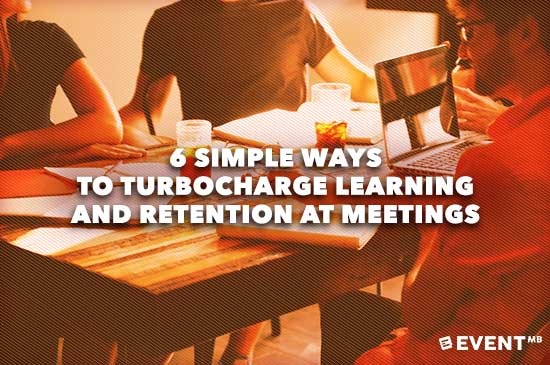Skift Take
How can you ensure attendees retain information long after the event is over, rather than forgetting their learning and new-found knowledge the moment they leave the venue? Here are 6 simple ways to turbo-charge learning and retention at your next meeting.
Meeting design at it’s core is heavily centred around getting attendees to education sessions in order to gain specialized information. Studies have shown, however, that the traditional lecture model for content delivery leads to abysmal retention rates (some research reports as low as 5%). The problem is that there is not enough importance placed on what actually happens within our meeting rooms to guarantee success. Below are 5 effective and proven methods to incorporate into your next meeting.
Incorporate Storytelling
Storytelling has been used throughout history as one of the most potent ways of retaining large quantities of new information. In the Middle Ages, long before literature was widely accessible and ‘twitter’ was simply the sound a bird makes, minstrels were kept on staff by monarchies in scores because of their unique oral storytelling ability to spread important news and breaking events.
Weaving an interesting narrative into educational content not only provides entertainment value and instant connection to the storyteller (speaker), it also has been scientifically shown to promote ‘neural coupling’ – a phenomenon that connects an audience with a speaker by prompting their own memories of past experiences that relate to that story. Encouraging your expert speakers to draw from their own lives in their content delivery will also foster a sense of inclusivity and reliability – making them seem more trustworthy and approachable beyond the session.
Promote Messy Learning
Breaking out of the talking-head mode for your educational sessions is the best way to guarantee participant engagement and lock in learning. Try incorporating psychologist Jerome Bruner’s Theory of Development through Discovery Learning (‘messy learning’) into your breakout sessions. Discovery Learning simply means having students actively participate in the teaching process through verbal and tactile exercises. This is a great way to reformat a session to allow for real-life problem solving situations.
Challenge your speakers to prime participants to be open to new information by introducing hard questions and experiments and having them wrestle with the answers before delivering their content and giving the correct answers. This will motivate the group and give them a more personalized, tailored learning experience. Like storytelling, this teaching style prompts participants to draw on past experiences and knowledge to help learn new things – more neural coupling magic!

Get People Talking
In the classroom, teachers regularly call on their students to answer questions. This keeps everyone on their toes and sets an expectation of them to verbalize the educational content in their own way (and lock it in!). As event professionals, our clients expect our participants to gain valuable resources to use in the real world, and in order to do that they need to be able to communicate what they’re learning effectively. Prompting participants for answers to questions and encouraging group discussions will help the speaker assess what needs to be reiterated and help facilitate a deeper understanding of the material.
A great way to put this into practice is to hire a Learning Coach to facilitate talk-back sessions throughout the entire meeting. An education expert who is also a speaker is the best combination to help keep your program flowing with maximum engagement from your attendees. This also helps to take the pressure off specialists who aren’t the most seasoned speakers but have vital information to share.
Negotiate the Space
One of the simplest hacks for amping up learning lies in how we set up our meeting spaces. Beyond the basics – lighting, temperature, noise level, etc. it is extremely important to consider how the participants and the speaker negotiate the space they have and maximize the capability for movement.
To satisfy the content delivery suggestions above, putting participants in a theatre style setting or in full rounds where half the table has to crane their neck doesn’t make sense. Small groupings, half rounds, comfortable ‘living room’ style seating with amenities that aid in learning (water, notebooks, pens, worksheets) should be the prerogative. Similarly, putting your speaker on an inaccessible stage or statically at a podium clicking through Powerpoint slides does nothing to promote the inclusive, discovery-based learning methods your participants need. Your speaker should be able to interact directly with groups of participants and weave through the group with ease to answer questions, highlight discoveries, and promote that approachable personality that will last beyond the meeting.

Mindfulness and Intention Setting
Every meeting has a ‘Big Why’: the overarching objective that we have a responsibility as event professionals to help our stakeholders achieve. But despite our best efforts, sometimes the big why gets lost because time and budgets are just too tight and programs are just too crowded.
The good news is that it’s really simple to circle back to the big why by reiterating the purpose of the meeting and checking in on it throughout your program. Use your learning coach, conference moderator, or MC to communicate your message and lead talk back sessions that update everyone on the things the group is learning, their successes, and the set-backs they are having. Remind your attendees that there is a reason they traveled, took time out of their busy schedules, and put their personal lives on hold to be in that room. Being engaged in the purpose for being in that room is imperative to the learning process.
Value Wellness Breaks
Active breaks during a work-day and vacations from work are generally accepted practices to promote productivity, engagement and physical wellness. It makes sense that these principles should also be applied to conferences and meetings. Breaks that give attendees enough time to rest and switch gears are imperative to help them be in the best position to learn. Often times our programs are so jam packed that attendees miss out on entire sessions to catch up on business emails or deal with family issues. Switching to something physically active to break up the day (mid-day yoga anyone?) or getting outside and participating in a teambuilding activity like a scavenger hunt ALONG with breaks between sessions for attendees to catch up on work/life matters will go a long way in keeping everyone happy and engaged all day long.
In Conclusion
As event professionals, we can’t control the content our expert speakers and educators need to communicate, but we can shift the format of our meetings to create the best possible content delivery and learning environment for our participants and bust through the 5% retention wall. All of these small changes work to promote inclusivity and active participation; bonus benefits for both the participants and speakers that they will feel well beyond the meeting by promoting an ongoing dialogue and sense of community.





